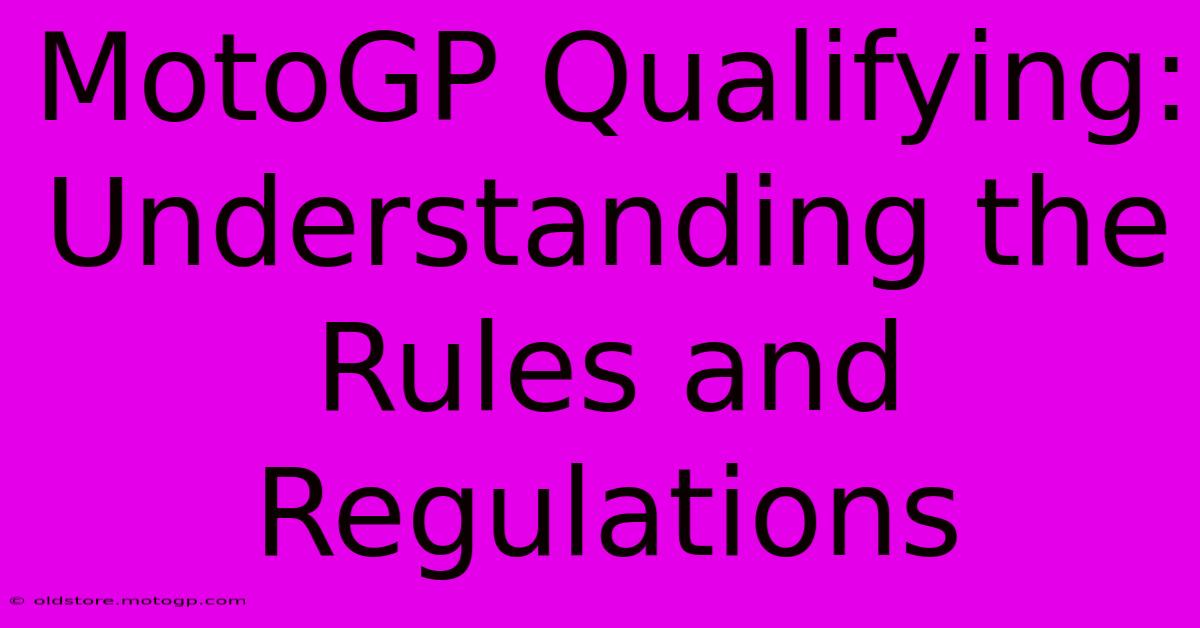MotoGP Qualifying: Understanding The Rules And Regulations

Table of Contents
MotoGP Qualifying: Understanding the Rules and Regulations
MotoGP qualifying is a crucial part of the weekend, determining the starting grid for the race. Understanding the rules and regulations governing this process is key to appreciating the drama and strategy involved. This guide will break down the qualifying format, highlighting the intricacies and implications for riders and teams.
The Qualifying Format: A Step-by-Step Breakdown
The current MotoGP qualifying format is designed to maximize excitement and showcase the riders' skills. It consists of three sessions:
Q1 (15 minutes):
- Participants: The 10 riders who were slowest in the combined Free Practice sessions (FP1, FP2, and FP3) participate in Q1.
- Objective: The top two riders from Q1 progress to Q2. The remaining eight riders will start the race from positions 13-20. This means performance in free practice directly impacts qualifying.
Q2 (15 minutes):
- Participants: The top 10 riders from the combined Free Practice sessions automatically qualify for Q2, along with the two riders who progressed from Q1.
- Objective: This session determines the all-important front row and the starting grid positions from first to twelve. The rider with the fastest lap time secures pole position.
Key Rules and Regulations:
- Track Limits: Riders must respect track limits throughout qualifying. Exceeding these limits, even marginally, can result in lap times being deleted. This adds another layer of challenge and tension. The race direction monitors this closely.
- Yellow Flags: Yellow flags indicate a dangerous situation on the track (e.g., a crash). Riders must slow down significantly under yellow flags, and overtaking is generally prohibited. Ignoring yellow flags can lead to penalties.
- Mechanical Issues: If a rider suffers a mechanical failure during qualifying, it's up to the team to rectify the problem quickly, or the rider may be at a significant disadvantage.
- Penalties: Various penalties can be applied for rule infractions, ranging from warnings to grid position penalties or even race bans. These penalties can significantly impact the outcome of the race.
- Timekeeping: Precise timing is essential. Every thousandth of a second counts, creating a high-pressure environment for both riders and their teams.
Strategy and Tactics in Qualifying:
MotoGP qualifying isn't just about raw speed; it's a strategic game. Teams and riders carefully consider factors like:
- Tire Choice: Selecting the correct tires for qualifying is crucial. The choice involves balancing performance and durability. Different tire compounds offer varying levels of grip.
- Fuel Load: The amount of fuel carried during qualifying influences bike handling and performance. A lighter bike will generally be faster, but too little fuel can compromise race strategy.
- Slipstream: Drafting behind another rider can provide a significant speed advantage, especially on long straights. Strategic positioning is therefore critical in qualifying. This creates a dynamic and exciting aspect of the qualifying sessions.
- Wind Conditions: Wind plays a significant role. Strong headwinds or crosswinds can impact lap times, requiring riders to adjust their lines and riding styles.
The Importance of Qualifying:
A good qualifying performance is crucial for race success. Starting from a front row position significantly improves the rider's chances of victory. A poor qualifying result, however, can make winning the race exceptionally difficult.
Conclusion:
MotoGP qualifying is a thrilling spectacle that combines raw speed, strategic thinking, and intense competition. Understanding the rules and regulations, along with the various strategic considerations, enhances the viewing experience and highlights the immense skill and pressure faced by the world's best motorcycle racers. The quest for pole position is often as dramatic as the race itself.

Thank you for visiting our website wich cover about MotoGP Qualifying: Understanding The Rules And Regulations. We hope the information provided has been useful to you. Feel free to contact us if you have any questions or need further assistance. See you next time and dont miss to bookmark.
Featured Posts
-
Experience The Excitement Moto Gp Austin 2025
Feb 25, 2025
-
Cota Qualifying The Insiders Playbook
Feb 25, 2025
-
Moto Gp On Tnt Sports Edge Of Your Seat Action
Feb 25, 2025
-
Austin Gp Concert Where Music Meets Motorsport
Feb 25, 2025
-
Mind Games Austin Sprint Race Time Mental Strategies
Feb 25, 2025
